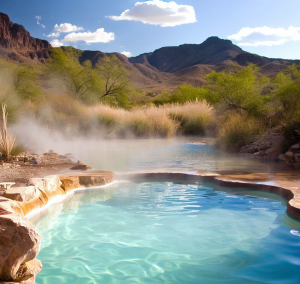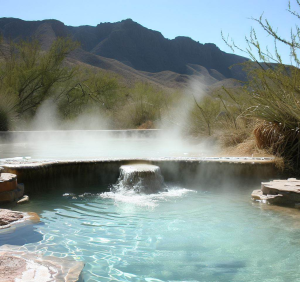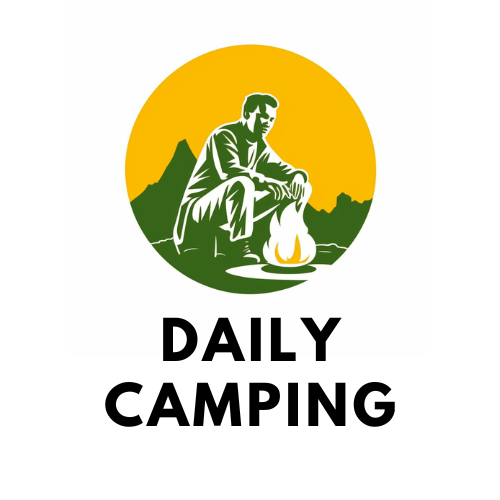
Big Bend National Park, located in Texas, is a place of natural beauty and cultural diversity. The park covers over 800,000 acres of diverse landscapes, from desert to mountains, from canyons to rivers. One of the most fascinating features of the park is the presence of hot springs, which are heated by geothermal processes deep underground and emerge at the surface with mineral-rich water.
History of the Hot Springs
The hot springs in Big Bend National Park have a long history of human use and occupation. The earliest evidence of human presence near the springs dates back to over 9,000 years ago, when Paleo-Indians left behind rock art on the limestone cliffs along the Rio Grande. The rock art depicts animals, humans, geometric shapes, and symbols that reflect the beliefs and lifestyles of these ancient people1.
Later, Native American groups such as the Chisos, Jumano, Mescalero Apache, and Comanche also visited the springs for their healing and spiritual properties. They called the springs Boquillas, which means “little mouths” in Spanish, referring to the many small streams that flow into the Rio Grande from the nearby mountains2.
The first European explorers to encounter the springs were Spanish missionaries and soldiers in the 17th and 18th centuries. They named the area Agua Caliente, which means “hot water” in Spanish. They also reported seeing Native Americans bathing and trading at the springs3.
In the late 19th and early 20th centuries, the springs attracted settlers, ranchers, miners, and entrepreneurs who saw the potential for developing a resort and spa. The most famous of these was J.O. Langford, who arrived in 1909 and built a bathhouse, a hotel, a store, a post office, and a school at the site. He promoted the springs as a cure for various ailments and diseases, such as rheumatism, skin problems, malaria, and tuberculosis. He also hosted guests from all over the country and even from Mexico, which was just across the river4.
Langford’s resort thrived until the 1930s, when a series of events led to its decline. These included the Great Depression, a flood that damaged the buildings, a border dispute that closed access to Mexico, and the creation of Big Bend National Park in 1944. Langford sold his property to the National Park Service in 1942 and moved away. The park service preserved some of the historic structures and artifacts at the site, but also demolished some of them for safety reasons5.
Today, visitors can still enjoy soaking in the hot spring, which is contained by the foundation remains of Langford’s bathhouse on the north bank of the Rio Grande. The spring water emerges at 105°F (41°C) and carries dissolved mineral salts that are reputed to have healing powers. The spring is also surrounded by scenic views of the river, the mountains, and the desert6.
How to Visit the Hot Springs
To visit the hot springs in Big Bend National Park, you need to drive or hike to the Hot Springs Historic District, which is located on the east edge of the park. The district is accessible by a two-mile gravel road that descends down a rough, narrow wash from Highway 385. The road is not suitable for motor homes or oversize vehicles. Alternatively, you can hike to the district from various trails in the park, such as Daniel’s Ranch Trailhead or Rio Grande Village Trailhead.
From the parking area at the end of the road or trail, you need to walk about 0.25 miles (0.4 km) to reach the hot spring. Along the way, you can explore the ruins of Langford’s resort buildings, the Hot Springs Post Office, the Hot Springs Cemetery, and the rock art panels on the cliffs.
The hot spring is open year-round from sunrise to sunset. There is no fee or reservation required to use it. However, there are some rules and regulations that you need to follow for your safety and enjoyment:
- Be respectful of others; soak only, and use no soaps or oils.
- Swimming is not recommended; be aware that adjacent river currents and depths can be unpredictable.
- Please help to keep the area clean by picking up trash.
- Alcoholic beverages and glass containers are prohibited.
- Overnight camping in the area of the Hot Springs is prohibited.
- It is illegal to purchase items from vendors operating on the Mexican side of the Rio Grande.
The hot spring can accommodate about six people at a time. The water level and temperature may vary depending on the season, the weather, and the river flow. Sometimes, the spring may be covered by the river or by rocks, mud, or debris. This may require some digging to form a suitable space for bathing.
Benefits of the Hot Springs
Soaking in the hot springs in Big Bend National Park can provide you with many benefits, both physical and mental. Some of these benefits are:
- Relaxation: The warm water and the natural setting can help you relax your muscles, reduce your stress, and improve your mood.
- Pain relief: The heat and the minerals in the water can help ease pain and inflammation caused by arthritis, injuries, or chronic conditions.
- Skin health: The minerals in the water can help nourish and cleanse your skin, as well as treat skin problems such as eczema, psoriasis, or acne.
- Detoxification: The water can help flush out toxins and impurities from your body, as well as stimulate your blood circulation and metabolism.
- Immunity: The water can help boost your immune system and fight off infections and diseases.
- Healing: The water can help heal wounds and burns, as well as speed up recovery from surgery or illness.

FAQs
- Does Big Bend National Park have hot springs? Yes, Big Bend National Park has several hot springs along the Rio Grande, but the most famous and accessible one is the Langford Hot Springs, which is located at the end of a two-mile gravel road near Rio Grande Village. The Langford Hot Springs is part of the Hot Springs Historic District, which preserves the remains of a former thermal spring resort that operated from 1914 to 19421.
- Where is the hot spring in Big Bend National Park? The hot spring in Big Bend National Park is located on the north bank of the Rio Grande, where Tornillo Creek enters the river, about four miles upstream from Boquillas Canyon and the Mexican village of Boquillas. The hot spring is contained by the foundation remains of the old bathhouse, which was built by J.O. Langford, the founder of the Hot Springs resort2. To reach the hot spring, you need to drive or hike to the Hot Springs Historic District and then follow a 0.5 mile round trip trail from the trailhead1.
- Can you swim in hot springs Big Bend? Swimming in hot springs Big Bend is not recommended, as the adjacent river currents and depths can be unpredictable and dangerous. The hot spring water is also very hot and may scald or burn you if you stay too long. The park service advises visitors to soak only, and use no soaps or oils, as they may contaminate the water or harm the wildlife. Alcoholic beverages and glass containers are also prohibited in the area1.
- How hot are Big Bend hot springs? The Big Bend hot springs are heated by geothermal processes and emerge at 105° F (40.6° C), which is about seven times hotter than the average human body temperature. The water carries dissolved mineral salts that are reputed to have healing powers, such as calcium carbonate, calcium sulfate, sodium sulfate, sodium chloride, and lithium. The water flow rate of the Langford Hot Springs was measured at 250,000 gallons a day in 1936, but it has decreased since then2.
Conclusion
The hot springs in Big Bend National Park are a unique and wonderful attraction that you should not miss when you visit the park. They offer you a chance to experience the natural and cultural history of the area, as well as enjoy the health and wellness benefits of the mineral-rich water. Whether you are looking for a relaxing soak, a therapeutic treatment, or a scenic adventure, you will find it at the hot springs in Big Bend National Park.


